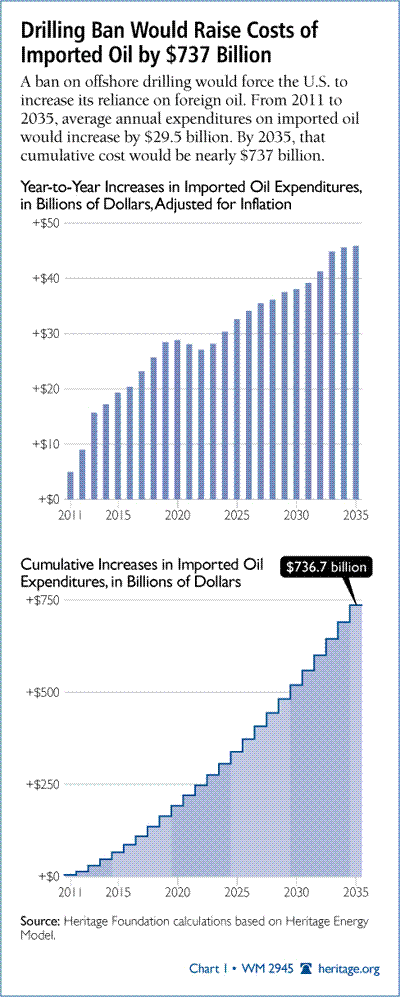Responding to the BP oil leak, President Obama instituted a moratorium on deepwater (over 500 feet) drilling. Though a judge ruled against the moratorium, drilling has not restarted. In addition, though no official moratorium was issued for drilling in shallower water, the permitting process has slowed considerably.[1]
The President has raised questions about the long-term necessity for drilling.[2] Others would take this argument much further and ban all drilling offshore.[3]
To help policymakers evaluate the arguments for limiting or eliminating offshore drilling, this paper analyzes the economic impact of a total offshore drilling ban on the U.S. economy. The authors use a mainstream model of the U.S. economy to simulate a policy change that prevents new wells from being drilled and allows offshore production to decline as the current set of wells reach the end of their productive lives.
Nipping Expansion in the Bud
The Department of Energy’s Energy Information Administration (EIA) projects that daily petroleum production will rise 18 percent between 2010 and 2035 and that daily production from offshore wells (in the lower 48 states) will rise by over 40 percent.[4] EIA also predicts that offshore drilling will supply significant increases in natural gas production. While total natural gas production will rise 16 percent over the same period, offshore production of natural gas will rise 63 percent, at which time it will be nearly a fifth of total domestic production.[5]
The reserves of petroleum are projected to rise by 5 billion barrels—even after extracting 57 billion barrels over the period 2010–2035. This happens because improvements in technology and price increases make previously uneconomic deposits economically viable. Further, because exploration and development are costly, it makes little sense to incur the costs of finding and extracting reserves that will not be used for decades.
In short, petroleum can be a major energy source for many decades. Consequently an offshore drilling ban’s impact on the U.S. would be felt for decades.

For example, between now and 2035 an offshore drilling ban would:
- Reduce GDP by $5.5 trillion,
- Reduce the average consumption expenditures for a family of four by $2,381 per year (and exceeding $4,000 in 2035),
- Reduce job growth by more than 1 million jobs by 2015 and more than 1.5 million jobs by 2030, and
- Increase the total expenditures for imported oil by nearly $737 billion.[6]
Effects on Consumer Prices
A permanent drilling ban would create a wedge between projected domestic oil production without the ban and the lower production levels with the ban in place. The lost petroleum output would have several impacts on the price of imported oil and thus consumer prices. For example, such a ban would necessitate the purchase of more imports to compensate for the lost domestic production. Because oil trades on world markets, this lost domestic production would cause world oil prices to rise—compounding the cost of the increased imports. The losses mount slowly, which means that the impact on oil prices and import costs will also mount slowly. The additional imported-oil cost exceeds $25 billion per year by 2018 and rises to over $45 billion per year by 2035.
Though, in percentage terms, the ban cuts domestic natural gas production half as much as domestic petroleum production, the price impact is greater because the natural gas market is predominantly regional, while the petroleum market is worldwide. Thus, there is less ability to buffer the domestic natural gas production cuts with additional imports. An offshore drilling ban, therefore, would likely lead to natural gas price increases of 10 percent by 2015, 23 percent by 2020, and 45 percent by 2035.
Since energy is a critical input for so many things, raising its cost will increase production costs throughout the economy. Though producers will pass most of the costs on to consumers, consumers will not be able to buy as much at these higher prices. Therefore, the higher energy prices cut the demand for all the other inputs, such as labor. As the higher costs for petroleum and natural gas ripple through the economy, there may be a few bright spots (such as suppliers of more energy-efficient capital goods), but the overall impact is decidedly negative.
An offshore drilling ban cuts domestic energy production, raises energy costs, and shrinks the nation’s economic pie. The broadest measure of economic activity, gross domestic product (GDP), drops $5.5 trillion over the period 2011–2035. Employment levels fall below those projected to occur without a ban in place. By 2020, employment would be 1.4 million jobs lower than without the ban. By 2030, the projected gap reaches 1.5 million jobs.
Of course, shrinking the economy makes families poorer. By 2020 the annual reduction in disposable income for a family of four exceeds $2,000. This lost income exceeds $3,000 per year in 2030 and is over $4,000 per year in 2035.
Pulling the Rug Out
Petroleum and natural gas play a vital role in the U.S. economy and are likely to remain critical to economic activity for decades to come. The Department of Energy expects offshore production to be a bigger supplier of the nation’s energy needs in the years ahead.
If a total ban on offshore drilling is implemented by 2011, then by 2035 Americans could expect national income (GDP) to drop by $5.5 trillion, total costs of imported oil to rise by $737 billion, total disposable income to decrease $54,000 per family of four, and job losses to exceed 1.5 million. A total ban on offshore drilling would pull the rug out from the economy’s incipient recovery.
David W. Kreutzer, Ph.D., is Research Fellow in Energy Economics and Climate Change and John L. Ligon is Policy Analyst in the Center for Data Analysis at The Heritage Foundation.



